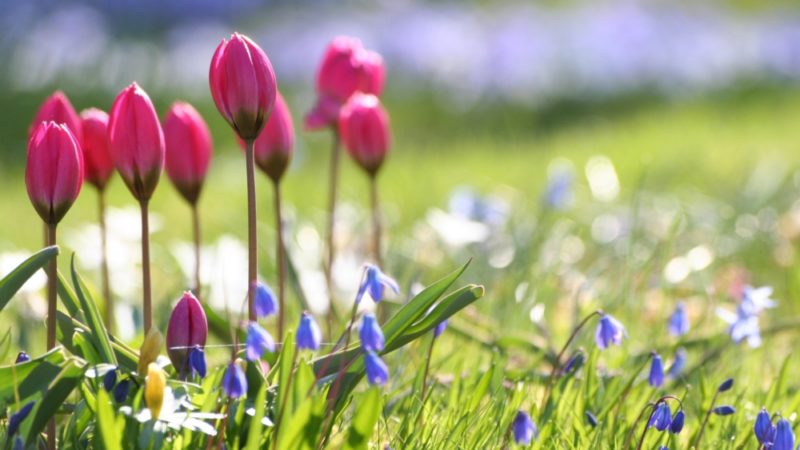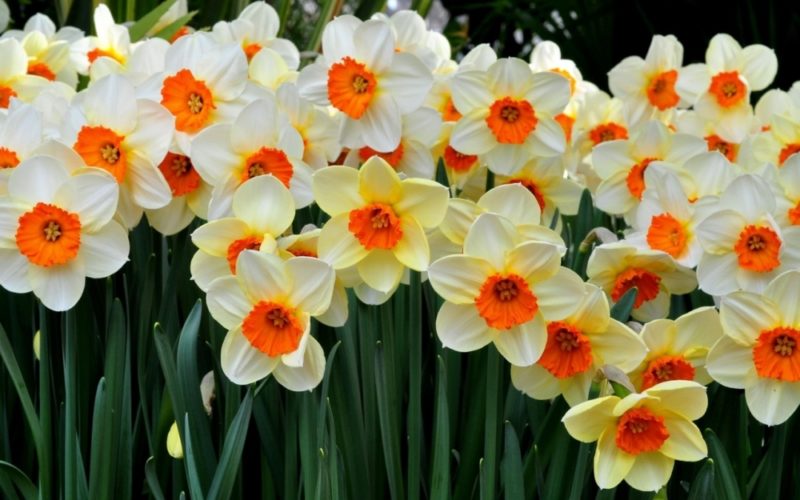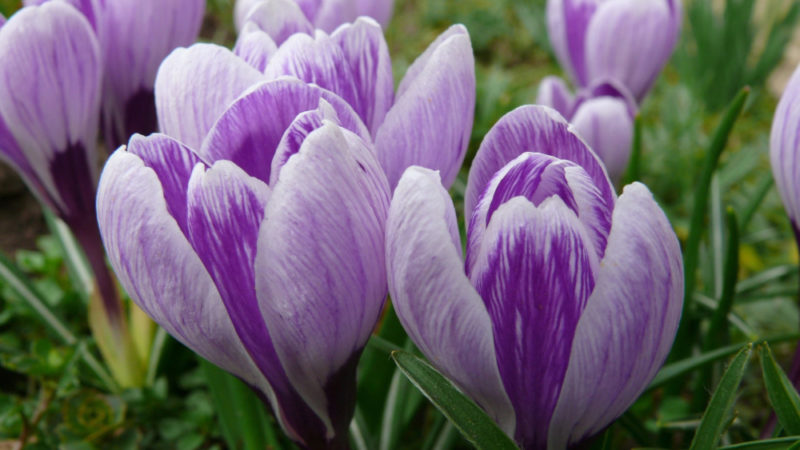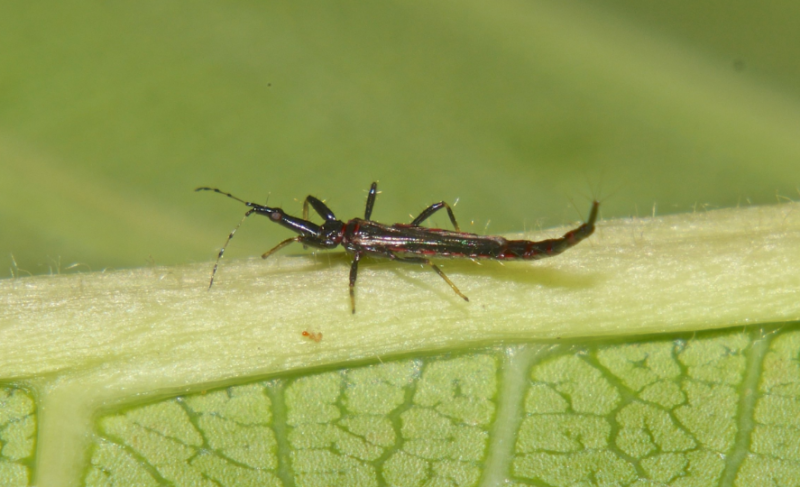With the arrival of heat in May parks, squares, summer cottages, fields and forests, May flowers bloom. The variety of shapes and colors of these very first messengers of spring is striking. Flower beds with early flowering plants do not allow to pass by. They attract admiring glances of passers-by.
Material Content:
Description of May Flowers
People are often interested in the question, why did some representatives of the flora become early flowering? The weather is still pretty cool, there are few insects, the snow has just melted, and they are already blooming.
The fact is that in April - May in the forest, park or square there is still no foliage on the trees. Around the light, the sun's rays reach the most shady corners. Good lighting has become the main reason for the evolution of primroses. The earth is saturated with moisture, without which they cannot grow normally. In April - May there are no rivals taking away precious water. This is the second reason for the change.
The life cycle of primroses lasts only 2 to 3 months. During this time, they manage to grow, bloom, give fruits and seeds.
The plants themselves, mainly during this time turn yellow, lie down, dry out. The aboveground part disappears, and bulbs, tubers or rhizomes are preserved in the soil, which will come to life next spring and decorate the forest again.
All early flowering plants are perennials. All of them can be propagated by seeds and do it very originally. For the distribution of seeds using ants. On the fruits and seeds grow fleshy growths, rich in oil. These very thickenings attract ants. Insects take away gifts to their anthills, sometimes they lose them along the way. In spring, the seeds germinate, it happens, very far from the parent bush. Such early flowers have a beautiful name - ephemeroids.
List with titles and photos
Description of flowers blooming in May will take up a lot of space.The list is huge. Let us dwell on some of them.
Pansies, viola, tri-flowers, moths are violets. Immediately after the snow melts, these wildflowers open their buds. There are many legends about the origin of the name. One of them says that the beautiful girl Anyuta was turned into a flower because of her curiosity. Another legend claims that Anyuta died of love, and a beautiful flower grew up on her grave, which was named after the girl.
These flowers are interesting not only for their legends, but also for the method of scattering seeds. The ripened fruits resemble lanterns. Sashes squeeze out seeds upon drying. A silent shot occurs, the flashlights burst, the seeds fly out, like shells. They fly far away, in spring they germinate and give rise to a new flower.
Tulips belong to bulbous plants and are known to everyone. There are hundreds of varieties and species. Among them, early flowering are of particular interest. They come in 2 types: simple and terry. Their only drawback is a short stem in some species, but the variety of varieties and colors is simply amazing.
World-famous early-flowering simple and terry tulips:
- Christmas marvel
- Christmas dream
- Pink trophy
- Couleur cardinal
- Brilliant star
- Olga
- Verona
- Monte orange
- Abba
Arabis refers to the early flowering. It is grown as a perennial and as an annual. Use as a groundcover. Its height does not exceed 30 cm. Creeping shoots have the ability to take root. The leaves are green, pubescent, whole, serrated along the edge. Inflorescences consist of simple or double flowers with a diameter of 15 mm. The color is different: light yellow, pink, white or purple. Flowers have a pleasant aroma. The fruit is a pod. Arabis refers to cruciferous and is a relative of cabbage, radish, mustard, horseradish. It looks very nice in groups with colorful views.
Known garden forms of plants:
- Sneeshaube. White inflorescences reach a length of 15 cm. Bush height - 25 cm;
- terry form reminds levkoy;
- pink - with large pink flowers. The length of the inflorescence is 12 cm, with a bush height of 20 cm.
The following species of arabis are found in the wild:
- Caucasian;
- bruise;
- running out;
- stunted;
- breakwater;
- ciliary leaf;
- Ferdinand.
In wildlife there are quite a lot of early flowering shrubs. These include holoflowered or winter jasmine. During flowering, it looks wonderful: yellow flowers shine along the entire length of the shoots in the axils of the leaves. Excellent hedges are obtained from this unpretentious shrub. He is not afraid of pruning, so you can grow jasmine in a bonsai style. Without pruning, planted in tubs of plants, they need support.
Dicenter - perennial, height - from 15 cm to 3 meters. The fleshy roots are deep. The stem is branched, straight. Long flowering - 30 - 45 days. Flowers resemble hearts of pink, red, yellow, purple and white. It has several names: “Heart of Jeannette” in France, “Flower of the Heart” in Germany, “Broken Heart” in Russia.
The center has more than 20 types. Some of them bloom from early spring to late autumn. The most famous dicenter is gorgeous, or gorgeous pink, with white or alo-pink flowers. The roots of the dicentres are poisonous, the transplant is carried out with gloves and does not taste the spine.
Climbing dicenter is a little-known species, which is a liana-shaped plant. Grows in the Himalayas. The flowers are white or yellow-golden.
Breeders have created many new varieties of dicentres:
- Gold Hart;
- Spectabilis Alba;
- "Golden vine" - climbing;
- "Gorgeous Valentine";
- Burning Hearts;
- "White gold".
The winding variety “Golden Tears” with bright yellow inflorescences is suitable for the cold climate. It blooms all season, resistant to frost.
Aquilegia belongs to the ranunculaceae family, belongs to grassy perennials. It has other names: dove, slipper of elves, bell.Aquilegia is a biennial. The plant is very decorative. The flowers of the garden catchment are double and simple, large and small, two and one-color, with and without spur. The color scheme is striking from pale white to bright red and purple.
Known varieties:
- Hensol Harebell;
- Alba
- Caerulea;
- "Clementine";
- Columbite.
Each grower can choose the most suitable variety for their flower beds.
Garden primrose is very popular among gardeners. Another name is spring primrose. Most species are perennials, although annual and biennial plants are found. Spring primrose is popularly called "rams".
Varieties of early flowering include varieties:
- Julia's primrose: “Schneekissen”, “Lady Green”, “Sylvia”;
- ordinary: Virginia, Cerulea, Danova Bicolor;
- high: "Duplex", "Gelle Farben", "Gold Lace";
- polyanthus: Pacific Giant, Crescendo, Francesca;
- eyelet, or ciliary: “Max”, “Hanni”, “Louis”, “Nymph”;
- fine-toothed: “Alba”, “Ruby”, “Lilak”;
- kortuzovidnaya, or Altai: "Primate."
Daffodils belong to bulbous plants. They are known to all. Breeders tried and bred flowers with a wide variety of shapes of flowers and colors: apricot, orange, red, pink daffodils adorn the cities and villages in early spring. Their flowers are simple and double, cyclamen-shaped, tubular, crown-shaped, holly. More than 60 species of wild-growing and more than 35,000 hybrid species are known.
Interesting varieties of daffodils:
- Bravoure;
- Carlton
- Golden Aura;
- Ice Follies
- Passionale
- Pinza.
If you like daffodils, then you can make any choice, because there are so many varieties and varieties.
Lilac - a bush that blooms in spring. According to the timing of flowering, three groups are distinguished:
- early
- medium flowering;
- late.
Early varieties include hybrids:
- "Mulatto";
- Buffon.
Flowering begins in late April, lasts until early May.
May lily of the valley is a herbaceous perennial plant. On a curved peduncle, there are 6 to 20 white flowers. The fruit is a red berry.
All the aerial parts of the lily of the valley are poisonous, used in medicine as medicinal raw materials.
Terry garden varieties with pink flowers were bred:
- Latifolia
- Rosea
With yellow longitudinal stripes on the leaves:
- Aureovariegata or Lineata or Striata.
In lilies of the Prolificans variety, branched pedicels form crowded inflorescences.
The aroma of lily of the valley is used in perfumery; it is produced artificially.
Growing Features
Growing early flowering plants has several characteristics.
Early flowering affects the choice of planting location. Most often they are used to decorate tree-trunk circles of deciduous decorative and fruit trees. Many of them do not need spring watering, accumulating nutrients in tubers and bulbs. In addition, after the snow melts in the soil, there is already enough moisture.
Planting bulbous primroses is made in autumn.
Rhizomes are planted in the spring.
Outdoor landing
It is best to plant primroses in the fall, in late September - early October. Before frosts, plants will have time to take root, but will not grow.
- Before planting, the bulbs should be soaked for 30 minutes in a pink solution of potassium permanganate.
- Planting is carried out to a depth of 3 times more than the bulb.
- The distance is observed in the amount of 3 diameters of planting material.
- With the onset of frost, the beds are mulched with straw, peat, dry leaves.
Landing in open ground depends on the root system. If the culture propagates by bulbs or tubers, planting is carried out according to all the rules for them. Shrubs and plants with a root system are planted in planting pits.
The cultures under discussion are frost-resistant, like partial shade. When planted in the sunshine, their foliage dries out, so the flower will leave winter naked. Next spring, it may not rise or weaken so that over time it dries anyway.
A couple of weeks before planting, the soil is prepared: they are dug up, weed is selected, a layer of compost or multicomponent fertilizer is added, and mixed. Tuberous and bulbous spring flowers can grow in one place up to six years. Then they are dug up and planted in another place, because they can be returned to the former only after 5 years.
Miniature bulbs: crocuses, muscari, sprouts can be planted on the front lawn. Massive plantings look especially beautiful when the bulbs are close to one another. You can mow the grass after the flowers have completely dried.
Alpine hills are decorated with colorful crocuses, snowdrops, hyacinths. As an alternative, early flowering plants can be planted next to large-leaved perennials.
How to care for plants
The rules of care are weeding, loosening, watering, top dressing. Lilac and jasmine pruned. Thicken plantings are thinned out, new ones are planted instead of old ones.
Loose permeable soils are suitable for bulbous and tuberous early flowers. In wetlands, the plants rot. Before winter, planting sites are mulched with compost or foliage. Planted for 3 to 4 years.
Such flowers are covered only in places with frosty winters. In the southern regions, they winter well without shelter.
Protection against diseases and pests
Early flowering susceptible to disease and pest attacks. So that your work is not in vain, regularly inspect the flowers and at the first sign of illness or the appearance of pests, use insecticidal and antifungal drugs.
It can be treated against scab and dry rot before planting. For this, the bulbs, rhizomes, tubers of flowers must be soaked for 30 minutes in a solution of potassium permanganate, taking 15 mg per 10 liters of water. Against thrips and onion mites, soaking in 10% solution of “Karbofos” or 20% solution of “Celtan” for 20 to 30 minutes is used.
Early flowers will decorate your site. If you try, you can pick up plants so that the flower beds are constantly in bloom. Good luck!



















